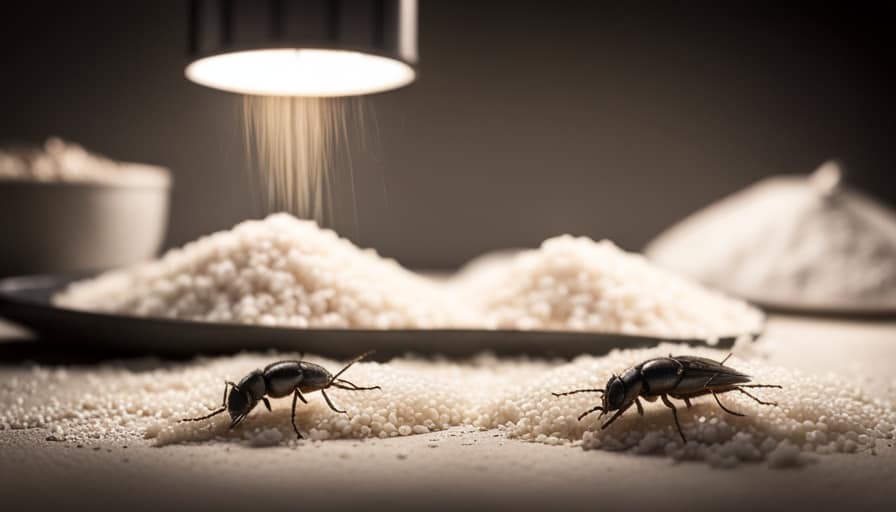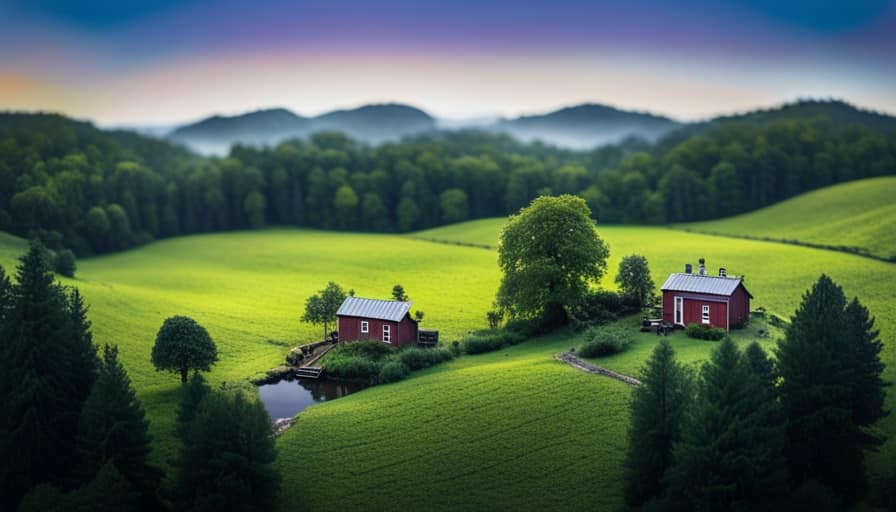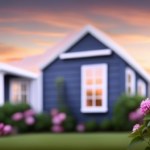Welcome to our guide on understanding the obsession with miniatures!
In this article, we will reveal the top 10 secrets to boxing life in a tiny house.
We have explored the world of small spaces to bring you clever solutions, functional designs, and innovative ideas.
Get ready to simplify your life, maximize storage, and create versatile living areas.

Join us as we uncover the secrets to stylish and sustainable living in a tiny house.
Let’s dive in and unlock the potential of your cozy abode!
Key Takeaways
- Utilize hidden compartments and space-saving furniture to maximize storage and functionality
- Incorporate multi-purpose areas and furniture designs to enhance versatility
- Embrace stylish and sustainable design principles using natural materials and energy-saving techniques
- Make use of organization essentials like vertical storage and unconventional solutions
Maximizing Storage: Clever Solutions for Small Spaces
We’ve got 10 clever solutions to help you maximize storage in your small space.
When it comes to living in a tiny house, making the most of every inch is crucial. One effective strategy is to utilize hidden compartments. These secret storage spaces can be found in unexpected places, like under the stairs or inside furniture pieces.

They provide ample room to store items that you don’t use frequently, keeping your living space clutter-free.
Another key solution is investing in space-saving furniture. This type of furniture is designed to serve multiple purposes, such as a sofa that can be transformed into a bed or a coffee table with built-in storage compartments. These innovative pieces aren’t only functional but also stylish, making them perfect for small spaces.
Designing for Functionality: Making Every Inch Count
Let’s explore 10 ways to design our tiny house for functionality, making every inch count. Functional design is essential when it comes to maximizing the limited space in a tiny house. One effective way to achieve this is by utilizing space-saving techniques.
For example, incorporating built-in storage solutions such as hidden cabinets and drawers can help to keep clutter at bay and free up valuable floor space. Another strategy is to invest in multi-functional furniture, such as a sofa that can also be used as a bed or a dining table that can be folded away when not in use.

Additionally, maximizing vertical space by installing shelves and utilizing wall-mounted storage can greatly increase storage capacity. By implementing these functional design principles and space-saving techniques, we can make the most of every inch in our tiny house, creating a more efficient and organized living space.
In the next section, we’ll delve into small space living hacks: secrets to simplifying your life.
Small Space Living Hacks: Secrets to Simplifying Your Life
In the next section, we’ll explore how to simplify our lives in a tiny house by implementing small space living hacks. Living in a small space requires us to be creative and resourceful in order to make the most of every inch.
One of the keys to simplifying our lives is to invest in space-saving furniture. These pieces are designed to maximize functionality while minimizing the amount of space they take up. By opting for a minimalist lifestyle, we can also reduce clutter and create a more peaceful living environment. This means only keeping the essentials and letting go of unnecessary belongings.

Creating Multi-Purpose Areas: The Key to Versatile Living
Our tiny house is small, but by creating multi-purpose areas, we can maximize the functionality and versatility of our living space. One effective way to achieve this is through the use of multi-functional furniture designs. These innovative pieces of furniture can serve multiple purposes, saving valuable space while still providing essential functionality. For example, a sofa bed can be transformed into a comfortable sleeping area at night, and a seating area during the day. Another strategy is to incorporate space-saving storage solutions. By utilizing vertical storage options such as wall-mounted shelves or overhead cabinets, we can make the most of our limited space. Additionally, utilizing furniture with built-in storage compartments can help keep our belongings organized and out of sight. By implementing these strategies, we can create multi-purpose areas that enhance the functionality and versatility of our tiny house.
| Multi-Functional Furniture Designs | Space-Saving Storage Solutions |
|---|---|
| Sofa bed | Wall-mounted shelves |
| Convertible dining table | Overhead cabinets |
| Murphy bed | Built-in storage compartments |
| Foldable desk | Under-bed storage |
| Nesting tables | Hidden compartments |
Stylish and Sustainable: Eco-Friendly Design Tips for Tiny Homes
When it comes to designing eco-friendly tiny homes, there are several key points to consider.
First, efficient space utilization is essential, maximizing every inch of the limited space available.
Second, using natural materials and resources can help reduce the environmental impact of the home.

Lastly, incorporating energy-saving techniques can help minimize energy consumption and make the tiny home more sustainable.
Efficient Space Utilization
We often find that maximizing space is key when designing a stylish and sustainable tiny home. Efficient space planning is crucial to make the most of every square footage available. In a tiny home, every inch counts, and it’s important to utilize the space efficiently to create a functional and comfortable living environment.
One way to maximize square footage is by incorporating multifunctional furniture. For example, a sofa that can convert into a bed or a dining table that can be folded and stored when not in use. This allows for flexibility and saves space.
Another strategy is to utilize vertical space by installing shelves or cabinets that go all the way up to the ceiling. This not only provides additional storage but also creates the illusion of a larger space.

Additionally, utilizing hidden storage solutions such as under-bed storage or built-in cabinets helps to keep the space clutter-free and organized.
Natural Materials and Resources
Using sustainable and renewable materials is essential for creating an eco-friendly tiny home. Natural building materials contribute to sustainable living by reducing the environmental impact and promoting a healthy living environment. When choosing materials for a tiny home, opt for options such as reclaimed wood, bamboo, cork, and natural stones.
These materials not only add a unique and stylish touch to the interior, but they also have a lower carbon footprint compared to synthetic alternatives. Additionally, using recycled materials like salvaged windows and doors can further reduce waste and contribute to a more sustainable lifestyle.
Energy-Saving Techniques
To maximize energy efficiency in our tiny home, we can implement a variety of stylish and sustainable techniques.

One of the most effective energy-saving techniques is to invest in insulation. Properly insulating the walls, floors, and roof can significantly reduce heat loss in the winter and heat gain in the summer.
Another technique is to install energy-efficient windows and doors that are designed to minimize air leakage. Utilizing natural light through large windows and skylights can also help reduce the need for artificial lighting during the day.
Additionally, incorporating innovative furniture ideas such as foldable and multi-functional pieces can optimize space and reduce energy consumption. For example, a dining table that can be folded down when not in use or a sofa that can be transformed into a bed can maximize functionality and save energy.
Organization Essentials: Keeping Clutter at Bay in a Compact Space
When it comes to living in a tiny house, one of the biggest challenges is keeping clutter at bay. That’s why maximizing storage solutions and utilizing multi-purpose furniture hacks are essential.

Maximizing Storage Solutions
We can make the most of our storage space by thinking creatively about how to utilize and organize it. In a tiny house, every inch counts, so it’s important to maximize storage solutions. Here are some space-saving techniques to help keep clutter at bay:
| Storage Solution | Benefits |
|---|---|
| Utilize vertical space | Install shelves or use hanging organizers to take advantage of wall space. This allows for more items to be stored without taking up valuable floor space. |
| Multi-functional furniture | Opt for furniture pieces that serve multiple purposes, such as ottomans with hidden storage or beds with built-in drawers. This helps maximize storage while minimizing the need for extra furniture. |
| Use under-bed storage | Utilize the space under your bed by using storage containers or drawers specifically designed for this purpose. This allows for easy access to items while keeping them out of sight. |
| Think outside the box | Look for unconventional storage solutions, like using a pegboard to hang kitchen utensils or utilizing the space behind doors with over-the-door organizers. This helps optimize storage in unexpected places. |
Multi-Purpose Furniture Hacks
Our compact space can stay clutter-free and organized by utilizing multi-purpose furniture hacks and essentials.
Space saving hacks and dual purpose furniture are key elements in maximizing functionality in a tiny house. By investing in furniture pieces that serve multiple purposes, such as a sofa that can also be used as a bed or a coffee table with hidden storage compartments, we can optimize the limited space available to us.
These multi-functional furniture items not only save space but also provide additional storage solutions, helping us keep clutter at bay.

Additionally, incorporating foldable or collapsible furniture options can further enhance the flexibility of our living space.
With these innovative furniture solutions, we can create a well-organized and functional environment in our compact home.
Navigating Small Kitchens: Tips for Cooking and Dining in a Tiny House
In the tiny house, we’ve to navigate the challenges of a small kitchen when it comes to cooking and dining.
Cooking efficiency is key in maximizing the limited space available. One strategy is to invest in multi-purpose kitchen appliances that can perform multiple functions, such as a toaster oven that can also broil and bake. Additionally, using stackable cookware and utensils can save valuable cabinet space.

When it comes to dining, space-saving strategies are essential. One option is to opt for a drop-leaf table that can be folded down when not in use. Another alternative is to utilize bar stools or foldable chairs that can be easily stored away.
Innovative Furniture Ideas: Making the Most of Limited Space
With limited space available, we can maximize our living area by exploring innovative furniture ideas that make the most of every inch. In a tiny house, it becomes crucial to find space-saving innovations and compact design solutions.
Here are three furniture ideas that can help us make the most of our limited space:
-
Multi-functional furniture: Opt for pieces that serve multiple purposes, such as a sofa bed or a coffee table with storage compartments. These versatile pieces can save space and provide additional functionality.

-
Wall-mounted furniture: Consider installing wall-mounted shelves, tables, and even beds. This frees up valuable floor space and creates a more open and spacious feel in our tiny house.
-
Foldable furniture: Invest in foldable furniture, like collapsible dining tables and chairs. These items can be easily folded and stored away when not in use, giving us the flexibility to have larger furniture when needed.
Outdoor Living in a Tiny House: Expanding Your Living Space
When it comes to tiny house living, finding creative solutions to maximize outdoor space is essential.
In order to expand your living area, there are various techniques that can be employed to enhance the exterior of your tiny house.

From utilizing rooftop decks to incorporating foldable furniture and vertical gardens, there are numerous ways to transform your outdoor space into a functional and inviting area.
Creative Outdoor Space Solutions
We love finding creative ways to expand our living space in a tiny house, especially when it comes to outdoor living. In a limited space, outdoor gardening can be a great way to bring nature into your tiny house. Consider vertical gardening solutions such as hanging planters or wall-mounted herb gardens to maximize your outdoor space. Another creative idea is to utilize the roof of your tiny house as a living garden, where you can grow vegetables or create a rooftop oasis.
In addition to gardening, thinking outside the box when it comes to seating can also enhance your outdoor living experience. Incorporate multi-purpose furniture like benches with built-in storage or folding chairs that can be easily stored when not in use. By incorporating these outdoor gardening and seating ideas, you can create a functional and inviting outdoor living space in your tiny house.
To further enhance your tiny house exteriors, let’s explore ways to make the most of your limited outdoor space.

Enhancing Tiny House Exteriors
To make the most of our limited outdoor space, let’s explore five ways to enhance the exteriors of our tiny house and expand our living space.
One of the first things to consider is tiny house landscaping. By carefully planning and designing our outdoor area, we can create a beautiful and functional space that complements our tiny house. Adding plants, flowers, and even a small vegetable garden can bring life and color to our surroundings.
Another way to enhance our tiny house exteriors is by choosing the right exterior color scheme. Opting for light colors can make our tiny house appear larger and brighter, while darker colors can create a cozy and intimate feel.
Tiny House Decor Secrets: Tricks to Create a Spacious and Stylish Interior
By utilizing clever storage solutions and incorporating multi-functional furniture, we can maximize the space and create a stylish interior in our tiny house.

When it comes to designing the decor of a tiny house, there are a few key secrets to keep in mind. Here are some tricks to create a spacious and stylish interior:
-
Choose a light and neutral tiny house color palette: Light colors can make a space feel larger and more open. Opt for shades of white, cream, or pastels to create a bright and airy atmosphere.
-
Incorporate natural light: Utilize windows and skylights to bring in as much natural light as possible. This won’t only make the space feel larger but also create a warm and inviting ambiance.
-
Use mirrors strategically: Mirrors can create the illusion of more space by reflecting light and making the room appear larger than it actually is. Place mirrors strategically to maximize their effect.

Frequently Asked Questions
Can You Provide Some Tips for Organizing a Small Bathroom in a Tiny House?
In a small bathroom, we focus on maximizing space by using vertical storage, installing shelves and hooks, and opting for compact fixtures. This creates a functional and organized space in our tiny house.
How Can I Incorporate a Home Office Into a Tiny House Design?
When designing a tiny house, it’s important to consider incorporating a home office. We can create a functional workspace by maximizing vertical storage, utilizing foldable furniture, and incorporating natural light.
What Are Some Creative Ways to Maximize Storage in a Bedroom With Limited Space?
To maximize storage in a small bedroom, we can get creative with our solutions. We can use wall-mounted shelves, under-bed storage containers, and multi-functional furniture like beds with built-in drawers.
Are There Any Suggestions for Creating a Separate Sleeping Area in a Small Open-Concept Living Space?
Creating a cozy reading nook and incorporating a loft bed are great suggestions for creating a separate sleeping area in a small open-concept living space. It maximizes space and adds functionality to your tiny home.

Can You Offer Any Advice on How to Create an Outdoor Entertaining Area in a Tiny House?
To create an outdoor entertaining area in a tiny house, we recommend utilizing multi-functional furniture that can be easily stored when not in use. Consider incorporating a portable grill for outdoor cooking and creating a garden space using vertical gardening techniques.
Conclusion
In conclusion, the secrets to boxing life in a tiny house are truly mind-blowing.
From maximizing storage to creating multi-purpose areas, these ingenious solutions will revolutionize your small space living experience.
You’ll be amazed at how stylish and sustainable your tiny home can be, and navigating the small kitchen will become a breeze.

With innovative furniture ideas and the option for outdoor living, you’ll never feel cramped again.
Get ready to transform your tiny house into a spacious and stylish haven!
I’m Theodore, and I love tiny houses. In fact, I’m the author of Tiny House 43, a book about tiny houses that are also tree houses. I think they’re magical places where imaginations can run wild and adventures are just waiting to happen.
While tree houses are often associated with childhood, they can be the perfect adult retreat. They offer a cozy space to relax and unwind, surrounded by nature. And since they’re typically built on stilts or raised platforms, they offer stunning views that traditional homes simply can’t match.
If you’re looking for a unique and romantic getaway, a tree house tiny house might just be the perfect option.
















